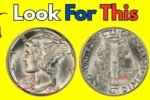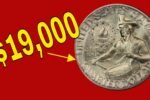Rare 1944 Wheat Penny : When it comes to rare coins, few stir as much excitement among collectors and casual treasure hunters alike as the 1944 Wheat Penny with no mint mark. While millions of pennies were struck in 1944, this particular version is shrouded in mystery, rarity—and potential value. If you’ve ever dumped out a jar of pennies hoping to strike it rich, this one is definitely worth knowing about.
What Is the 1944 Wheat Penny?
The 1944 Wheat Penny is part of the famous Lincoln Wheat Cent series, featuring Abraham Lincoln on the obverse and two wheat stalks on the reverse. These were minted from 1909 to 1958 and are well-loved for their classic American design.
What makes 1944 notable is that this was the first year the U.S. Mint returned to using copper (actually a bronze alloy of 95% copper and 5% zinc) after the one-year experiment with steel cents in 1943, which were made to conserve copper for the war effort during World War II.
So What’s the Big Deal with No Mint Mark?
Most 1944 pennies were minted in Philadelphia, Denver (marked with a “D”), or San Francisco (“S”). However, a regular Philadelphia-minted coin won’t carry a mint mark. So at first glance, a 1944 penny with no mint mark might not seem special—unless it was made with the wrong metal.
Here’s the twist: a few 1944 pennies were accidentally struck on leftover steel planchets from 1943. These steel coins are silver in color, magnetic, and incredibly rare—only a few dozen have been confirmed. These are the true hidden gems.
How to Tell If You Have the Rare One
If you come across a 1944 penny with no mint mark, take a closer look. Here’s a quick test guide:
- Color: Most 1944 pennies should be a rich copper-brown. If yours looks silver or grayish, it might be steel.
- Magnet Test: Use a household magnet. If the coin sticks, it’s made of steel.
- Weight Check: Steel cents weigh about 2.7 grams, while copper ones weigh closer to 3.11 grams. A precise digital scale helps.
- Expert Verification: If your penny passes these tests, get it authenticated by a grading service like PCGS or NGC. This step is essential for resale value and authenticity.
How Much Is It Worth?
If you truly have a 1944 steel Wheat Penny with no mint mark, congratulations—you could be sitting on a coin worth between $75,000 and $150,000 or more, depending on condition. Even lower-grade examples fetch tens of thousands at auction.
Copper 1944 no-mint-mark pennies, on the other hand, are much more common. In circulated condition, they’re typically worth 2 to 10 cents. Uncirculated ones might bring a few dollars. The steel version is what everyone’s hunting for.
Frequently Asked Questions (FAQs…)
Q1: What makes the 1944 Wheat Penny with no mint mark so rare?
A: While most 1944 pennies were made of copper and are common, a few were mistakenly struck on leftover steel planchets from 1943. These rare 1944 steel pennies with no mint mark (Philadelphia Mint) are extremely valuable due to the error and limited quantity produced.
Q2: How can I tell if I have the rare 1944 steel penny?
A: Look for these key signs:
- Color: It should appear silver or grayish, not coppery.
- Magnet Test: If it sticks to a magnet, it’s likely steel.
- Weight: Steel pennies weigh around 2.7 grams, while copper ones weigh about 3.11 grams.
- Professional Verification: Always have the coin authenticated by experts like PCGS or NGC to confirm it’s genuine.
Q3: Does a 1944 penny without a mint mark automatically mean it’s valuable?
A: No. The Philadelphia Mint didn’t use mint marks in 1944, so most no-mint-mark pennies from that year are common copper coins. Only the steel version is ultra rare and valuable.
Q4: How much is a 1944 steel penny with no mint mark worth?
A: If verified to be genuine and in good condition, it could be worth $75,000 to $150,000 or more at auction. Even lower-grade versions sell for tens of thousands of dollars.
Final Thoughts: Keep Your Eyes Peeled
It’s easy to overlook a penny, but the 1944 no-mint-mark steel Wheat Penny is a stunning reminder that valuable treasures can be hiding in plain sight—perhaps even in your pocket change or a dusty jar in the attic.
Next time you sort through your coins, don’t just glance—check the date, test the metal, and you might just discover your own hidden treasure.




